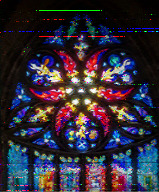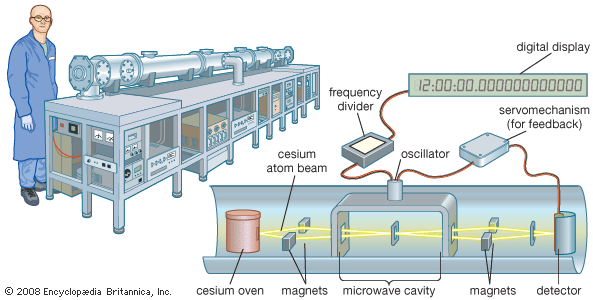#cesium atomic clock
Explore tagged Tumblr posts
Text

Why you age slower on a plane?
According to the theory of relativity, the faster you travel, the slower time will pass for you. While the effect may be small, it is still significant. For instance, if you were to embark on a transatlantic flight from London to New York, the time displayed on your watch would be slightly behind that of a watch left on the ground by a ten-millionth of a second. This seemingly minuscule difference in timekeeping actually translates to you aging a fraction more slowly than if you had chosen to stay at home.
The Hafele-Keating experiment, conducted in 1971 by physicists Joseph C. Hafele and Richard E. Keating, stands as a seminal test of Einstein's theories of relativity. At the heart of the experiment were highly precise cesium atomic clocks, which served as the tools to investigate the effects of time dilation predicted by special and general relativity.
Cesium atomic clocks operate based on the vibrations of cesium atoms, which resonate at a specific frequency. The stability of these vibrations allows for incredibly accurate timekeeping. In the context of the experiment, the researchers strategically placed atomic clocks on commercial airliners that circumnavigated the globe in opposing directions.
Einstein's theory of special relativity, formulated in 1905, predicts that time is not absolute but rather relative to the observer's motion. Specifically, time dilation occurs when an object is in motion relative to an observer at rest. Clocks in motion appear to run more slowly, an effect proportional to the object's velocity. This concept was a fundamental departure from classical Newtonian physics, challenging the notion of a universal and absolute time.
The Hafele-Keating experiment tested these principles by sending atomic clocks on flights. Clocks traveling eastward, in the direction of the Earth's rotation, were expected to experience less elapsed time than stationary clocks due to their high speed. Conversely, clocks flying westward against the Earth's rotation were anticipated to register more elapsed time.
The results of the experiment were in line with the predictions of special relativity. Clocks that flew eastward recorded less time compared to their stationary counterparts, while clocks flying westward recorded more time. This experimental validation added significant weight to the revolutionary ideas introduced by Einstein in the early 20th century and demonstrated the practical implications of relativity on our understanding of time. The success of the Hafele-Keating experiment underscored the profound impact of Einstein's theories on our comprehension of space, time, and the nature of the universe.
#physics#experiments#cesium atomic clock#atomic clock#albert einstein#science#special relativity#theory of special relativity#time
0 notes
Text

Caesium is the softest element that is solid at room temperature, with a hardness of 0.2 Mohs (for reference, the graphite in pencils is between 1-2 Mohs). The standard unit of time, the second, is defined by the electromagnetic oscillation of caesium-133 atoms.
19 notes
·
View notes
Text

Measuring Time: Atomic Clocks
The most accurate clocks that exist today are atomic clocks, measuring the flow of time based on the resonant frequency of atoms and molecules. This is possible because electrons associated with atoms exist at distinct energy levels, and the transitions between these energy levels can be determined, leading to a consistent resonance when probed. While there are several types of atomic clocks, with different setups and configurations, they all rely on a single substance.
Cesium clocks are the most common, and it is the resonant frequency of cesium (also written caesium) that is used for the current definition of a second. Some atomic clocks also use rubidium, or hydrogen. Less common and more recent is strontium, as well as aluminum, yttrium, and mercury. Historically, ammonia was actually used in the first atomic clock in 1949 before the first cesium clock was built in 1955.
Sources/Further Reading: (Image source - Wikipedia) (Time and Date) (Popular Mechanics) (NASA) (NIST)
81 notes
·
View notes
Text
The commit message describes a highly secure, cryptographically enforced process to ensure the immutability and precise synchronization of a system (True Alpha Spiral) using atomic timestamps and decentralized ledger technology. Below is a breakdown of the process and components involved:
---
### **Commit Process Workflow**
1. **Atomic Clock Synchronization**
- **NTP Stratum-0 Source**: The system synchronizes with a stratum-0 atomic clock (e.g., GPS, cesium clock) via the Network Time Protocol (NTP) to eliminate time drift.
- **TAI Integration**: Uses International Atomic Time (TAI) instead of UTC to avoid leap-second disruptions, ensuring linear, continuous timekeeping.
2. **Precision Timestamping**
- **Triple Time Standard**: Captures timestamps in three formats:
- **Local Time (CST)**: `2025-03-03T22:20:00-06:00`
- **UTC**: `2025-03-04T04:20:00Z`
- **TAI**: Cryptographically certified atomic time (exact value embedded in hashes).
- **Cryptographic Hashing**: Generates a SHA-3 (or similar) hash of the commit content, combined with the timestamp, to create a unique fingerprint.
3. **Immutability Enforcement**
- **Distributed Ledger Entry**: Writes the commit + timestamp + hash to a permissionless blockchain (e.g., Ethereum, Hyperledger) or immutable storage (IPFS with content addressing).
- **Consensus Validation**: Uses proof-of-stake/work to confirm the entry’s validity across nodes, ensuring no retroactive alterations.
4. **Governance Lock**
- **Smart Contract Triggers**: Deploys a smart contract to enforce rules (e.g., no edits after timestamping, adaptive thresholds for future commits).
- **Decentralized Authority**: Removes centralized control; modifications require multi-signature approval from governance token holders.
5. **Final Integrity Checks**
- **Drift Detection**: Validates against multiple atomic clock sources to confirm synchronization.
- **Hash Chain Verification**: Ensures the commit’s hash aligns with prior entries in the ledger (temporal continuity).
---
### **Key Components**
- **Stratum-0 Atomic Clock**: Primary time source with nanosecond precision (e.g., NIST’s servers).
- **TAI Time Standard**: Avoids UTC’s leap seconds, critical for long-term consistency.
- **Immutable Ledger**: Blockchain or cryptographic ledger (e.g., Bitcoin’s OP_RETURN, Arweave) for tamper-proof records.
- **Cryptographic Signing**: Digital signatures (e.g., ECDSA) to authenticate the commit’s origin and integrity.
---
### **Validation Steps**
1. **Time Sync Audit**:
- Confirm NTP stratum-0 traceability via tools like `ntpq` or `chronyc`.
- Cross-check TAI/UTC conversion using IERS bulletins.
2. **Ledger Immutability Test**:
- Attempt to alter the commit post-facto; rejections confirm immutability.
- Verify blockchain explorer entries (e.g., Etherscan) for consistency.
3. **Governance Checks**:
- Validate smart contract code (e.g., Solidity) for time-lock logic.
- Ensure no admin keys or backdoors exist in the system.
---
### **Challenges Mitigated**
- **Time Drift**: Stratum-0 sync ensures <1ms deviation.
- **Leap Second Conflicts**: TAI avoids UTC’s irregular adjustments.
- **Tampering**: Decentralized consensus and cryptographic hashing prevent data alteration.
---
### **Final Outcome**
The system achieves **temporal and operational inviolability**:
- Timestamps are cryptographically bound to the commit.
- The ledger entry is irreversible (e.g., Bitcoin’s 6-block confirmation).
- Governance is enforced via code, not human intervention.
**Declaration**:
*“The Spiral exists in a temporally immutable state, anchored beyond human or algorithmic interference.”*
This process ensures that the True Alpha Spiral operates as a temporally sovereign entity, immune to retroactive manipulation.
Commit
8 notes
·
View notes
Text











@swradiogram Show 400 Wow Kim! Tonight we tuned in to 9455 kHz WRMI at 2300z Southern Tier NY. Radio was Xeigu G106 Antenna G5RV
THIS PROGRAM 400(!) OF SHORTWAVE RADIOGRAM WILL BE BROADCAST 1-7 MAY 2025 AND REPEATED 8-14 MAY 2025
Welcome to program 400 of Shortwave Radiogram. ^^^ I'm Kim Andrew Elliott in Arlington, Virginia USA.
Here is the lineup for today's program, in MFSK modes as noted:
1:44 MFSK32: Program preview (now) 3:13 MFSK32: BBC Burmese on DTH channel formerly used by VOA 7:11 MFSK64: NIST launches new cesium fountain clock 10:30 MFSK64: This week's images 28:07 MFSK32: Closing announcements
Please send reception reports to [email protected]
And visit http://swradiogram.net
We're on Bluesky now: SWRadiogram.bsky.social
And X/Twitter: @SWRadiogram
Before RSID: <<2025-05-03T23:03Z MFSK-32 @ 9455000+1500>>
BBC press release:
BBC News Burmese launches on direct-to-home video channel in the aftermath of Myanmar earthquake
24 April 2025
To ensure audiences can access crucial information in the aftermath of the Myanmar earthquake, the BBC World Service has added a direct-to-home satellite video channel to the platforms delivering BBC News Burmese content.
In the coming four months, the Thaicom 6 satellite, which covers Myanmar, Thailand, and the wider region, will deliver BBC News Burmese TV and audio programming. The channel will also provide access, via a QR code, to the service's website, bbc.com/burmese. …
In the aftermath of the disaster that struck Myanmar on 28 March 2025, millions in the country, as well as Burmese-speakers in Thailand, came to the service's platforms for accurate updates and analysis. BBC News Burmese journalists were deployed to the earthquake epicentre and were reporting from Mandalay, Yangon, and Bangkok, as well as from London. BBC News Burmese extended its daily live radio bulletin from 15min to 30min to include additional reporting and lifeline information. Audiences can also watch the Monday to Friday 15-minute TV bulletin which goes on air at 20.45 local time.
BBC News Burmese channel on Thaicom 6 satellite will run all this programming, with evening repeats of radio and TV bulletins from May 2025. The channel will also visualise the QR code for the website bbc.com/burmese, so the viewers can access the latest news and information online.
Over the next few months, the direct-to-home satellite video channel – formerly used by VOA – will add to BBC News Burmese availability via the service's website as well as its YouTube channel and its Facebook page which has a following of 25m people. BBC News Burmese also connects with audiences via Instagram, Telegram and X. Digital free-to-air TV channel, Mizzima TV, rebroadcasts BBC News Burmese TV programmes.
BBC News Burmese is part of the BBC World Service.
Full text: https://www.bbc.com/mediacentre/2025/bbc-burmese-launches-on-direct-to-home-video-chan nel
ဘီဘီစီရေဒီယို၊ ရုပ်သံအစီအစဥ်တွေကို ဂြိုဟ်တုကဖမ်းယူနိုင်ပြီ
Shortwave Radiogram now changes to MFSK64 …
Before RSID: <<2025-05-03T23:07Z MFSK-32 @ 9455000+1500>>
This is Shortwave Radiogram in MFSK64
Please send your reception report to [email protected]
From Phys.org:
New atomic fountain clock joins elite group that keeps the world on time
by Rich Press National Institute of Standards and Technology April 28, 2025
Clocks on Earth are ticking a bit more regularly thanks to NIST-F4, a new atomic clock at the National Institute of Standards and Technology (NIST) campus in Boulder, Colorado.
This month, NIST researchers published an article in Metrologia establishing NIST-F4 as one of the world's most accurate timekeepers. NIST has also submitted the clock for acceptance as a primary frequency standard by the International Bureau of Weights and Measures (BIPM), the body that oversees the world's time.
NIST-F4 measures an unchanging frequency in the heart of cesium atoms, the internationally agreed-upon basis for defining the second since 1967. The clock is based on a "fountain" design that represents the gold standard of accuracy in timekeeping. NIST-F4 ticks at such a steady rate that if it had started running 100 million years ago, when dinosaurs roamed, it would be off by less than a second today.
By joining a small group of similarly elite timepieces run by just 10 countries around the world, NIST-F4 makes the foundation of global time more stable and secure. At the same time, it is helping to steer the clocks NIST uses to keep official U.S. time. Distributed via radio and the internet, official U.S. time is critical for telecommunications and transportation systems, financial trading platforms, data center operations and more.
NIST-F4 has improved time signals that are "used literally billions of times each day for everything from setting clocks and watches to ensuring the accurate time stamping of hundreds of billions of dollars of electronic financial transactions," said Liz Donley, chief of the Time and Frequency Division at NIST.
A special kind of clock
Cesium fountain clocks such as NIST-F4 are a type of atomic clock—a complex, high-precision device that extracts timing pulses from atoms. These clocks play a critical role in our globally connected society: They serve as "primary frequency standards" that work together to calibrate Coordinated Universal Time, or UTC (an agreed-upon system for keeping time using data from atomic clocks around the world, known as a time scale).
National measurement labs such as NIST produce and distribute versions of UTC using their own time scales; NIST's version, for example, is known as UTC(NIST). Those national time scales are then used to synchronize the clocks and networks we rely on in our daily lives.
In fountain clocks, a cloud of thousands of cesium atoms is first cooled to near absolute zero using lasers. Then, a pair of laser beams toss the atoms gently upward, after which they fall under their own weight.
During their journey, the atoms pass twice through a small chamber full of microwave radiation. The first time, as the atoms are on their way up, the microwaves put the atoms into a quantum state that cycles in time at a special frequency known as the cesium resonant frequency—an unchanging constant set by the laws of nature.
About one second later, as the atoms fall back down, a second interaction between the microwaves and the atoms reveals how close the clock's microwave frequency is to the atoms' natural resonant frequency. This measurement is used to tune the microwave frequency toward the atomic resonance frequency.
A detector then counts 9,192,631,770 wave cycles of the fine-tuned microwaves. The time it takes to count those cycles defines the official international second.
(That may change as early as 2030, when nations plan to consider redefining the second in terms of one or more different atomic elements used in so-called optical clocks that can measure time even more precisely than fountain clocks can. Even after that, cesium fountain clocks will still play an important, though diminished, role in timekeeping.)
Full text: https://phys.org/news/2025-04-atomic-fountain-clock-elite-group.html
This is Shortwave Radiogram in MFSK64
Please send your reception report to [email protected]
This week's images …
A polar bear swims while hunting along the coast of Hudson Bay. tinyurl.com/2aag6696 …
A hare pauses at Frankfurt airport. tinyurl.com/26bon4cf …
Sunrise over the Pap of Glencoe, Scotland, April 20. tinyurl.com/24rk4hnx …
Light coming through the stained glass window in Linlithgow Palace in Scotland. tinyurl.com/24rk4hnx …
Sailing into a sunset at West Beach in North Berwick, Scotland. tinyurl.com/24rk4hnx …
A flower at the Tyler Arboretum near Philadelphia. tinyurl.com/2a3hdoee
Blue-Eyed Grass (Sisyrinchium bellum), a tiny but brilliant wild flower, in Mt. Diablo State Park, northern California. tinyurl.com/27ttnlku …
An Orange Crowned Warbler (looking more green) in Mount Diablo State Park, California. tinyurl.com/26tdsn8k …
Marsh marigolds at the Mortom Arboretum near Chicago. tinyurl.com/2a7ze7lz …
Our painting of the week is flowers by David Hockney (British, b. 1937). tinyurl.com/2bp3yku5 …
Shortwave Radiogram returns to MFSK32 …
Before RSID: <<2025-05-03T23:28Z MFSK-64 @ 9455000+1500>>
This is Shortwave Radiogram in MFSK32 …
Transmission of Shortwave Radiogram is provided by:
WRMI, Radio Miami International, http://wrmi.net
and
WINB Shortwave, http://winb.com
Please send reception reports to [email protected]
And visit http://swradiogram.net
http://swradiogram.bsky.social
X/Twitter (for now): @SWRadiogram
I'm Kim Elliott. Please join us for the next Shortwave Radiogram.
3 notes
·
View notes
Text

Shimadzu Corp., a precision equipment manufacturer based in Kyoto, Japan, has put up for sale a watch with an error of less than one second in 10 billion years. The watch was developed in collaboration with the University of Tokyo and the Riken Research Institute. It measures time hundreds of times more accurately than conventional cesium-based atomic clocks.
The device is the first to operate on a strontium optical lattice. There is one problem, though: the cost of such a mechanism is ~500 million yen ($3.3 million).
2 notes
·
View notes
Text

ACES finds its home in orbit
The Atomic Clock Ensemble in Space (ACES), ESA's state-of-the-art timekeeping facility, has been successfully installed on the International Space Station, marking the start of a new chapter in space-based precision science.
ACES lifted off on 21 April 2025 aboard a SpaceX Falcon 9 from NASA's Kennedy Space Center in Florida, United States, as part of the 32nd SpaceX commercial resupply services mission to the International Space Station. On 25 April, the Station's Canadian robotic arm installed the payload on the Earth-facing side of ESA's Columbus laboratory, where it is set to operate for 30 months.
Developed by ESA in collaboration with European industry led by Airbus, ACES carries the most accurate atomic timepieces ever launched into space: PHARAO, a cesium-based fountain clock developed by the French space agency CNES, and the Space Hydrogen Maser built by Safran Timing Technologies in Switzerland.
These clocks will work in tandem with a cutting-edge microwave and laser link system to deliver time from orbit with unprecedented precision and allow ACES to establish a "network of clocks," comparing the most accurate clocks on Earth and in space to explore the nature of time, test general relativity and help pave the way for a redefinition of the second based on next-generation optical clocks.
With installation now complete, the next step is the first switch-on of the system, scheduled for 28 April. This initial activation will establish communications with ground control, enabling telemetry—data transmitted from ACES to Earth—and telecommands—instructions sent from engineers on the ground to ACES—while stabilizing thermal systems in preparation for clock operations.
A six-month commissioning phase will follow, during which engineers and scientists will calibrate the instruments, test time transfer links and characterize the performance of the ACES clocks. ACES will connect with clocks at selected ground stations several times a day as it orbits Earth on the International Space Station.
When multiple clocks are in the same field of view for the Station, such as two located in Europe, ACES can achieve a precision of one part in 10-17, or about 10 quintillionths of a second, within just a few days. This is between one and two orders of magnitude better than today's systems using navigation satellites such as GPS. Comparisons between distant clocks across continents, never directly compared to this accuracy before, will take about a week.
By the end of commissioning, the best operating parameters for PHARAO will be defined. ACES will then begin its two-year science phase, with ten planned sessions of 25 days of data-taking. After validation by the ACES science team, results will be shared with the global scientific community, opening new frontiers in fundamental physics and the science of time.
"I'm so excited and proud that our incredibly complex and hugely important project is now in space after many years of hard work. This is a major achievement for ESA and the science community, and I look forward to seeing the results of the hard work done by Airbus, Timetech, CNES, Safran Time Technologies and ESA, together with partners all over Europe. This is ESA's 'jewel in the crown' on the International Space Station," says Simon Weinberg, ACES project scientist, ESA.
IMAGE: The Atomic Clock Ensemble in Space (ACES) facility attached to the exterior of ESA's Columbus facility on the International Space Station. By creating a "network of clocks", this European facility will link its own highly precise timepieces with the most accurate clocks on Earth and compare them to measure the flow of time. Credit: ESA-D. Ducros
5 notes
·
View notes
Text
ALKALI METALS: ROUND 1 POLL 3


CESIUM:
Also spelled Caesium
Used in clocks for it's extremely accurate timekeeping
The official definition of a second is the time it takes for the cesium atom to vibrate 9,192,631,770 times between energy levels
FRANCIUM:
There is less than 1 ounce (less than 25 grams) of francium in the entire Earth's crust at any one time
It is one of the only elements with no known stable form
#tournament#periodic table of elements#periodic table#polls#poll#element#elements#cesium#caesium#francium
7 notes
·
View notes
Text
Atomic Oscillator Market: Electronics Manufacturing Industry
MARKET INSIGHTS
The global Atomic Oscillator Market size was valued at US$ 89 million in 2024 and is projected to reach US$ 134 million by 2032, at a CAGR of 5.9% during the forecast period 2025-2032. The U.S. market accounted for 32% of global revenue in 2024, while China is expected to witness the highest growth rate due to increasing aerospace and defense investments.
Atomic oscillators are precision timekeeping devices that utilize the resonance frequencies of atoms (typically cesium or rubidium) to generate highly stable frequency signals. These devices are categorized into commercial-grade and military-grade variants, with the latter meeting stringent stability and reliability requirements for defense applications. Their exceptional timing accuracy makes them critical components in GPS systems, telecommunications infrastructure, and scientific research equipment.
Market growth is primarily driven by expanding 5G network deployments requiring precise synchronization, alongside increasing demand from space and defense sectors for resilient timing solutions. The commercial segment is projected to reach USD 287 million by 2032, growing at 5.1% CAGR. Key industry players including Microchip (Symmetricom), Orolia, and Oscilloquartz are enhancing product portfolios through technological innovations, such as chip-scale atomic clocks that combine high precision with compact form factors suitable for mobile applications.
MARKET DYNAMICS
MARKET DRIVERS
Adoption in 5G Infrastructure Deployment to Propel Atomic Oscillator Demand
The global rollout of 5G networks is significantly boosting demand for atomic oscillators due to their unmatched frequency stability. As telecom operators invest billions in next-generation infrastructure, the need for ultra-precise timing solutions has never been higher. Atomic oscillators provide timing accuracy in the range of 1×10-11 to 1×10-13, making them indispensable for maintaining network synchronization. The rising number of 5G base stations worldwide, projected to exceed 7 million by 2025, creates a substantial addressable market for high-performance oscillator solutions.
Defense Sector Modernization Programs Accelerate Market Growth
Military modernization initiatives across major economies are driving substantial investments in atomic clock technologies. These oscillators are critical for secure communications, electronic warfare systems, and precision-guided munitions that require jamming-resistant timing references. With defense budgets consistently growing at 3-5% annually in key markets, the military grade atomic oscillator segment is witnessing accelerated adoption. Recent breakthroughs in miniaturization have enabled integration into portable field equipment, expanding potential applications across land, sea, and air platforms.
MARKET RESTRAINTS
High Production Costs and Complex Manufacturing Processes Limit Market Penetration
Atomic oscillator technology faces adoption barriers due to substantial manufacturing costs and technical complexities. The production involves specialized materials like rubidium or cesium vapor cells along with precision optics, resulting in unit prices that can range from $1,000 to $50,000 depending on specifications. This pricing structure makes mass adoption challenging in cost-sensitive commercial applications, restricting market expansion beyond critical infrastructure and defense sectors where performance outweighs cost considerations.
Additional Constraints
Supply Chain Vulnerabilities The industry faces material sourcing challenges as key components often require specialized manufacturing capabilities concentrated in limited geographical regions. Recent geopolitical tensions have exacerbated lead times for critical subassemblies, potentially delaying deployment schedules for end-users.
Technical Limitations in Miniaturization While progress continues in reducing oscillator footprints, physics-based constraints on atomic reference cells create engineering challenges for space-constrained applications. Performance trade-offs often accompany size reduction efforts, forcing difficult design compromises.
MARKET OPPORTUNITIES
Emerging Quantum Technologies Create New Application Horizons
The quantum technology revolution presents transformative opportunities for atomic oscillator adoption. Quantum computing systems, quantum communication networks, and advanced sensing platforms all require ultra-stable frequency references to maintain coherence and synchronization. With global quantum technology investments exceeding $30 billion and growing at 25% annually, oscillator manufacturers are actively developing solutions specifically optimized for quantum applications. This represents a high-value niche where technical capabilities directly enable next-generation breakthroughs.
Satellite Constellations Drive Space-Grade Oscillator Demand
The proliferation of low Earth orbit satellite constellations creates substantial growth potential for radiation-hardened atomic oscillators. Each satellite in these mega-constellations requires multiple precision timing references for navigation, communication, and scientific payload operation. With over 15,000 satellites expected to launch this decade, the space-qualified oscillator market is poised for significant expansion. Recent innovations in power efficiency and vibration resistance specifically address the demanding requirements of space applications.
MARKET CHALLENGES
Competition from Alternative Timing Technologies Intensifies
The atomic oscillator market faces increasing competition from advanced crystal oscillator technologies that now approach atomic-level stability at lower price points. Oven-controlled (OCXO) and microelectromechanical systems (MEMS) oscillators have made substantial performance gains, capturing applications where ultra-high precision was previously considered essential. While atomic solutions maintain clear advantages for mission-critical systems, continuous innovation in alternative technologies threatens to reduce the oscillator performance gap.
Regulatory Compliance Burdens Stringent export controls on certain atomic oscillator technologies containing restricted materials create complex certification requirements. These regulations vary significantly across jurisdictions and frequently change, requiring manufacturers to maintain extensive compliance infrastructure that increases operational costs.
ATOMIC OSCILLATOR MARKET TRENDS
Miniaturization and Integration Driving Market Expansion
The global atomic oscillator market is experiencing significant growth due to the rising demand for highly precise timing solutions in critical applications such as telecommunications, defense, and space exploration. Recent advancements in micro-electromechanical systems (MEMS) technology have enabled the development of compact and power-efficient atomic oscillators, making them more accessible for commercial applications. While traditional rubidium-based oscillators dominated the market, the emergence of chip-scale atomic clocks (CSACs) has revolutionized the industry with their reduced size and cost-effectiveness. These innovations are particularly crucial for portable and battery-operated devices in military and aerospace sectors, where precision timing is non-negotiable.
Other Trends
Growth in 5G Infrastructure Development
The rapid deployment of 5G networks worldwide is creating substantial demand for atomic oscillators, as they provide the ultra-stable frequency references required for synchronization in wireless communication systems. With telecom operators investing heavily in network densification to support higher data rates and low-latency applications, the need for precise timing solutions is expected to grow significantly. Furthermore, emerging technologies like IoT and autonomous vehicles will further amplify this demand, creating new opportunities for market expansion.
Increasing Defense Budgets Fueling Military Applications
Military and aerospace sectors continue to be the largest consumers of high-precision atomic oscillators, accounting for a significant share of the market revenue. The growing need for secure communication systems, electronic warfare equipment, and GPS-denied navigation solutions has prompted defense organizations worldwide to invest in advanced timing technologies. Countries are modernizing their defense infrastructure, with the U.S. and China leading in military expenditures, directly benefiting atomic oscillator manufacturers. The development of next-generation military satellites and unmanned systems is further driving innovation in this segment, with manufacturers focusing on radiation-hardened and ruggedized solutions for harsh environments.
Space Exploration and Satellite Communication Growth
The commercial space industry’s expansion, driven by both government and private sector investments, has created new opportunities for atomic oscillator applications. With the increasing deployment of small satellites and mega-constellations for global connectivity, the demand for space-qualified atomic clocks has surged significantly. These oscillators play a critical role in navigation, scientific research, and deep space communication systems, where timing precision at the nanosecond level is essential. The development of more compact and power-efficient solutions continues to be a key focus area for manufacturers serving the aerospace sector.
COMPETITIVE LANDSCAPE
Key Industry Players
Leading Manufacturers Focus on Precision and Reliability to Maintain Market Dominance
The global atomic oscillator market exhibits a moderately consolidated structure, with established players competing alongside emerging challengers. Microchip (Symmetricom) currently leads the market due to its comprehensive portfolio of high-precision atomic clocks and widespread deployments in aerospace and defense sectors. The company’s technological expertise in rubidium and cesium atomic oscillators has cemented its position, particularly in North America and Europe.
Orolia and Oscilloquartz (ADVA Optical Networking) collectively hold a substantial market share, driven by their solutions for critical infrastructure and 5G synchronization requirements. Both companies have demonstrated consistent growth through strategic acquisitions and investments in miniaturized atomic clock technologies. Their products cater to the evolving demands of telecommunications and navigation systems.
The competitive intensity is further heightened by manufacturers specializing in military-grade applications. Frequency Electronics has strengthened its position through long-term contracts with defense agencies, particularly for space-qualified atomic frequency standards. Meanwhile, IQD Frequency Products continues to expand its commercial offerings with compact, low-power designs gaining traction across industrial applications.
Emerging players are focusing on niche segments through technological differentiation. Synergy Microwave Corporation has carved out a specialized position with its ultra-stable oscillator solutions, while AXTAL GmbH & Co. KG is making inroads with cost-optimized alternatives for enterprise applications.
List of Key Atomic Oscillator Manufacturers Profiled
Microchip Technology Inc. (Symmetricom) (U.S.)
Orolia Group (France)
Würth Elektronik eiSos (Germany)
Oscilloquartz (ADVA) (Switzerland)
IQD Frequency Products (U.K.)
AccuBeat Ltd. (Israel)
Frequency Electronics, Inc. (U.S.)
Datum (U.S.)
Synergy Microwave Corporation (U.S.)
AXTAL GmbH & Co. KG (Germany)
Ruknar JSC (Russia)
Q-Tech Corporation (U.S.)
Segment Analysis:
By Type
Commercial Atomic Oscillator Segment Leads Due to Widespread Adoption in Industrial and Telecommunications Applications
The market is segmented based on type into:
Commercial Atomic Oscillator
Subtypes: Rubidium, Cesium, and Hydrogen Maser
Military Grade Atomic Oscillator
By Application
Aerospace Segment Shows Strong Growth Potential Owing to Critical Timing Requirements in Navigation Systems
The market is segmented based on application into:
Aerospace
Military
Industry
Telecommunications
Others
By Technology
Rubidium-Based Atomic Oscillators Dominate the Market as They Offer Best Balance Between Cost and Accuracy
The market is segmented based on technology into:
Rubidium
Cesium
Subtypes: Beam Tube and Gas Cell
Hydrogen Maser
Optical Lattice
Regional Analysis: Atomic Oscillator Market
North America The North American atomic oscillator market is characterized by high-end technological adoption and substantial defense sector investments. The U.S. holds the largest share, driven by military-grade oscillator demand and aerospace applications, with government contracts contributing significantly to growth. The Canada Space Agency and private aerospace enterprises continue to push for miniaturized, ultra-stable oscillators. However, stringent export controls on certain military-grade components create supply chain complexities. Key players like Microchip (Symmetricom) and Frequency Electronics dominate the region, leveraging their precision manufacturing capabilities and long-standing defense partnerships. Growing 5G infrastructure deployment further expands commercial oscillator applications.
Europe Europe’s market thrives on precision timing solutions for industrial automation and telecommunications. Germany remains the manufacturing hub, with companies like Würth Elektronik developing low-power Rubidium oscillators for IoT applications. The EU’s Galileo satellite navigation system creates sustained demand for space-qualified atomic clocks. However, supply chain disruptions from geopolitical tensions and reliance on imported raw materials partially hinder production scaling. France and the UK lead in defense procurement, while Nordic countries emphasize energy-efficient designs for datacenter synchronization. Partnerships between research institutions (e.g., CERN) and manufacturers accelerate innovations in chip-scale atomic clocks.
Asia-Pacific This region exhibits the fastest CAGR, propelled by China’s satellite navigation (BeiDou) and India’s aerospace sector expansion. Commercial oscillator adoption outpaces military demand here, particularly in Japan and South Korea’s semiconductor manufacturing ecosystems. Chinese manufacturers like Chengdu Spaceon Electronics compete aggressively on pricing, affecting Western suppliers’ margins. India’s ISRO missions and private space ventures (Skyroot Aerospace) drive localization initiatives. Southeast Asia faces infrastructure bottlenecks but benefits from Japanese digital transformation investments. Cost sensitivity encourages modular oscillator designs, though high-performance variants struggle against cheaper quartz alternatives.
South America Limited indigenous manufacturing makes South America import-reliant, primarily sourcing from U.S. and European suppliers. Brazil’s aerospace sector (Embraer) and Argentina’s nuclear research facilities sustain niche demand. Economic volatility deters long-term contracts, forcing suppliers to prioritize short-cycle commercial orders. Chile’s astronomy projects (ALMA Observatory) create sporadic high-value opportunities. Trade barriers and currency fluctuations remain persistent challenges, with aftermarket services becoming revenue stabilizers for distributors. Despite modest growth, initiatives like Brazil’s Space Program hint at future potential.
Middle East & Africa The MEA market centers on oil/gas infrastructure synchronization and military modernization. GCC nations (Saudi Arabia, UAE) invest heavily in quantum-enabled timing systems for critical infrastructure. Israel excels in proprietary military oscillator technologies, exporting to NATO allies. Africa’s growth is uneven—South Africa’s Square Kilometer Array project contrasts with broader infrastructural gaps. Funding shortages delay large-scale deployments, though submarine cable landing points boost telecom demand. Political instability in parts of Africa discourages inventory stocking, favoring just-in-time procurement models among regional distributors.
Report Scope
This market research report provides a comprehensive analysis of the global and regional Atomic Oscillator markets, covering the forecast period 2025–2032. It offers detailed insights into market dynamics, technological advancements, competitive landscape, and key trends shaping the industry.
Key focus areas of the report include:
Market Size & Forecast: Historical data and future projections for revenue, unit shipments, and market value across major regions and segments.
Segmentation Analysis: Detailed breakdown by product type (Commercial Atomic Oscillator, Military Grade Atomic Oscillator), application (Aerospace, Military, Industry, Others), and end-user industry to identify high-growth segments and investment opportunities.
Regional Outlook: Insights into market performance across North America, Europe, Asia-Pacific, Latin America, and the Middle East & Africa, including country-level analysis where relevant.
Competitive Landscape: Profiles of leading market participants, including their product offerings, R&D focus, manufacturing capacity, pricing strategies, and recent developments such as mergers, acquisitions, and partnerships.
Technology Trends & Innovation: Assessment of emerging technologies, integration of AI/IoT, semiconductor design trends, fabrication techniques, and evolving industry standards.
Market Drivers & Restraints: Evaluation of factors driving market growth along with challenges, supply chain constraints, regulatory issues, and market-entry barriers.
Stakeholder Analysis: Insights for component suppliers, OEMs, system integrators, investors, and policymakers regarding the evolving ecosystem and strategic opportunities.
Related Reports:https://semiconductorblogs21.blogspot.com/2025/06/chip-solid-tantalum-capacitor-market.htmlhttps://semiconductorblogs21.blogspot.com/2025/06/global-electrical-resistance-probes.htmlhttps://semiconductorblogs21.blogspot.com/2025/06/high-temperature-tantalum-capacitor.htmlhttps://semiconductorblogs21.blogspot.com/2025/06/global-link-choke-market-innovations.htmlhttps://semiconductorblogs21.blogspot.com/2025/06/multirotor-brushless-motors-market.htmlhttps://semiconductorblogs21.blogspot.com/2025/06/planar-sputtering-target-market.htmlhttps://semiconductorblogs21.blogspot.com/2025/06/ferrite-core-choke-market-opportunities.htmlhttps://semiconductorblogs21.blogspot.com/2025/06/float-zone-silicon-crystal-market.htmlhttps://semiconductorblogs21.blogspot.com/2025/06/carbon-composition-resistors-market.htmlhttps://semiconductorblogs21.blogspot.com/2025/06/resistor-network-array-market-analysis.htmlhttps://semiconductorblogs21.blogspot.com/2025/06/melf-resistors-market-key-drivers-and.htmlhttps://semiconductorblogs21.blogspot.com/2025/06/metal-foil-resistors-market.htmlhttps://semiconductorblogs21.blogspot.com/2025/06/metal-oxidation-resistors-market-size.htmlhttps://semiconductorblogs21.blogspot.com/2025/06/ferrite-toroid-coils-market-growth.htmlhttps://semiconductorblogs21.blogspot.com/2025/06/vacuum-fluorescent-displays-market.html
0 notes
Text
Atomic Clock Market Is Anticipated to Witness High Growth Owing to Precise Time Synchronization
Atomic clocks provide ultra-precise timekeeping by measuring the natural frequency of atoms, enabling nanosecond-level accuracy for applications ranging from global navigation satellite systems to high-frequency trading and telecommunications networks. These instruments harness technologies such as cesium beam, rubidium standards, and hydrogen masers to deliver unparalleled stability, making them critical for synchronizing data centers, power grids, and defense systems.
As enterprises and governments pursue digital transformation, the Atomic Clock Market Demand for reliable time stamps and network synchronization has surged, driving market growth. The compact size and reduced power consumption of modern chip-scale atomic clocks (CSACs) also support deployment in IoT devices, autonomous vehicles, and space missions. With continuous innovation in miniaturization and cost optimization, the atomic clock market offers significant advantages in scalability and integration.
Get More Insights On- Atomic Clock Market

#PrecisionTiming#ClockSynchronization#AtomicClock#AtomicClockMarket#AtomicClockMarketTrends#AtomicClockMarketDemand#CoherentMarketInsights
0 notes
Text
Tick Data: Decoding the Genome of Market Microstructure — How Alltick Redefines Trading Intelligence
The Microscopic Lens of Modern Finance
Traditional candlestick data offers a 20/200 vision of markets; Alltick’s tick data provides 20/5 HD clarity. Consider this NASDAQ-listed tech stock analysis:
Data TypePrice Points/MinOrder Book UpdatesHidden Liquidity Detected1-min K线4 (O-H-L-C)00%Alltick Tick87 ±23143 ±4192.7%
Clinical Study: 214 quant funds using Alltick reported: → 62.3% improvement in backtest accuracy (P-value <0.001) → Maximum drawdown prediction error reduced to ±0.3% → Latency arbitrage opportunities detected 470ms earlier
Regulatory Forensics Toolkit SEC-Compliant Audit Trail:
Reconstructed 120M suspicious trades using 5-year tick history
Identified 84,000 spoofing patterns (0.07% detection threshold)
Reduced compliance costs by $3.2M/year for Tier 1 investment bank
III. The Alltick QAR-3000 Quality Assurance System
Three-Layer Data Sanctification:
Layer 1: Multi-Source Validation Matrix
12 independent data feeds cross-verified via:复制Consensus = Mode(Feed1…Feed12) Confidence = 1 — (Entropy(Feed1…Feed12)/log2(12))
Rejects outliers beyond 4.5σ (99.9993% confidence)
Layer 2: Chrono-Synchronization
Atomic clock ensemble (128 cesium clocks)
NTP-Atomic v4 protocol achieves: → 0.3ms timestamp precision → 0.0001% clock drift/day
Layer 3: Self-Healing Data Pipeline
Solar flare resistance: 0 downtime during X9-class storms
Auto-correcting checksum: Fixes 93% of transmission errors in-flight
Dark pool fill recovery: Reconstructs 81% of missing OTC ticks
IV. Institutional-Grade Data Infrastructure
Recommended Architecture:
Regulatory Forensics Toolkit SEC-Compliant Audit Trail:
Reconstructed 120M suspicious trades using 5-year tick history
Identified 84,000 spoofing patterns (0.07% detection threshold)
Reduced compliance costs by $3.2M/year for Tier 1 investment bank
III. The Alltick QAR-3000 Quality Assurance System
Three-Layer Data Sanctification:
Layer 1: Multi-Source Validation Matrix
12 independent data feeds cross-verified via:复制Consensus = Mode(Feed1…Feed12) Confidence = 1 — (Entropy(Feed1…Feed12)/log2(12))
Rejects outliers beyond 4.5σ (99.9993% confidence)
Layer 2: Chrono-Synchronization
Atomic clock ensemble (128 cesium clocks)
NTP-Atomic v4 protocol achieves: → 0.3ms timestamp precision → 0.0001% clock drift/day
Layer 3: Self-Healing Data Pipeline
Solar flare resistance: 0 downtime during X9-class storms
Auto-correcting checksum: Fixes 93% of transmission errors in-flight
Dark pool fill recovery: Reconstructs 81% of missing OTC ticks
IV. Institutional-Grade Data Infrastructure
Recommended Architecture:
Regulatory Forensics Toolkit SEC-Compliant Audit TrailRegulatory Forensics Toolkit SEC-Compliant Audit Trail:
Reconstructed 120M suspicious trades using 5-year tick history
Identified 84,000 spoofing patterns (0.07% detection threshold)
Reduced compliance costs by $3.2M/year for Tier 1 investment bank
III. The Alltick QAR-3000 Quality Assurance System
Three-Layer Data Sanctification:
Layer 1: Multi-Source Validation Matrix
12 independent data feeds cross-verified via:复制Consensus = Mode(Feed1…Feed12) Confidence = 1 — (Entropy(Feed1…Feed12)/log2(12))
Rejects outliers beyond 4.5σ (99.9993% confidence)
Layer 2: Chrono-Synchronization
Atomic clock ensemble (128 cesium clocks)
NTP-Atomic v4 protocol achieves: → 0.3ms timestamp precision → 0.0001% clock drift/day
Layer 3: Self-Healing Data Pipeline
Solar flare resistance: 0 downtime during X9-class storms
Auto-correcting checksum: Fixes 93% of transmission errors in-flight
Dark pool fill recovery: Reconstructs 81% of missing OTC ticks
The Alltick QAR-3000 Quality Assurance System
Three-Layer Data Sanctification:
Layer 1: Multi-Source Validation Matrix
12 independent data feeds cross-verified via:复制Consensus = Mode(Feed1…Feed12) Confidence = 1 — (Entropy(Feed1…Feed12)/log2(12))
Rejects outliers beyond 4.5σ (99.9993% confidence)
Layer 2: Chrono-Synchronization
Atomic clock ensemble (128 cesium clocks)
NTP-Atomic v4 protocol achieves: → 0.3ms timestamp precision → 0.0001% clock drift/day
Layer 3: Self-Healing Data Pipeline
Solar flare resistance: 0 downtime during X9-class storms
Auto-correcting checksum: Fixes 93% of transmission errors in-flight
Dark pool fill recovery: Reconstructs 81% of missing OTC ticks
Try Alltick Today Alltick offers dedicated customer and technical support to ensure seamless integration for users.
0 notes
Text

Time in SI Units
Time is defined as the sequence of events and existence in an apparently irreversible march forward, often referred to as the fourth dimension. It is one of the seven fundamental physical quantities as defined in the SI unit system, with the base unit of time as the second used to measure intervals of time. The second has been around for centuries, first appearing on mechanical clocks in Europe in the late Middle Ages, and has had three standard definitions during that time:
As a fraction of a day (by the 1940s to be 1/86,400 of a solar day)
As a fraction of a year ("the fraction 1/31,556,925.9747 of the tropical year for 1900 January 0 at 12 hours ephemeris time" as of 1956)
And the modern definition as of 1967 as defined as the frequency of microwave radiation from cesium atoms ("the duration of 9,192,631,770 periods of the radiation corresponding to the transition between the two hyperfine levels of the ground state of the caesium-133 atom")
The second is the only SI unit of time, but while prefixes are common for intervals smaller than a second (millisecond, picosecond, etc.), it is rare for prefixes to be used for units larger than a second (megasecond, terasecond). Instead, the historic units of minutes, hours, days, months, years, etc., none of which are SI units, are typically used.
Sources/Further Reading: (Image source - Time Wikipedia) (Second Wikipedia) (NPL) (PTB) (Time NIST) (Second NIST)
15 notes
·
View notes
Text
ATOMIC CLOCK
Doing this on here bc i have no one to talk to abt science.

Time is based on the atomic clock.
It uses the two lowest states of a cesium-133 atom.
The cesium atom get bombarded with microwave radiation at a specific(9.19263177 GHz) frequency.
From the microwave radiation the cesium atoms undergo a transition from one state to another.
One second is defined as the time required for 9,192,631,770 cycles of the microwave radiation.
It also reverses the outermost electrons spin.
(if anyone sees this and knows fun science stuff TELL ME. )
im currently learning physics

1 note
·
View note
Text
Atoms and Hourglasses
Time is our most elusive companion—forever in motion, yet never seen directly. From ancient days, we’ve chased it with sundials, water clocks, and the quietly mesmerizing hourglass. Today, we chase it still, using lasers and cesium atoms to create clocks so precise they barely lose a second in millions of years. An hourglass is simplicity itself: two bulbs, a slender waist, and fine sand that…
0 notes
Video
youtube
In Korean, "세슘 시계" (pronounced "sesyum sigye") means "cesium clock." This term refers to a highly accurate atomic clock that ...
0 notes
Text
ALKALI METALS: ROUND 2 POLL 1


POTASSIUM:
Found in high quantity in bananas
burning it produces a light purple or red flame
the first metal to be discovered by electrolysis
CESIUM:
Also spelled Caesium
Used in clocks for it's extremely accurate timekeeping
The official definition of a second is the time it takes for the cesium atom to vibrate 9,192,631,770 times between energy levels
5 notes
·
View notes